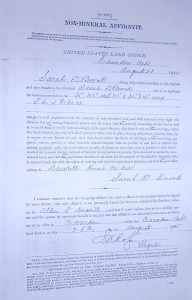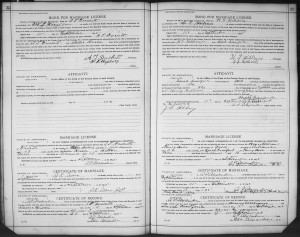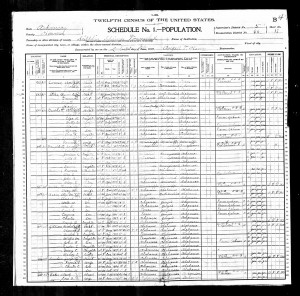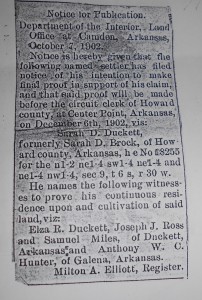Three weeks before Sarah Drusilla (Sallie”) Brock married Allen Turner Duckett (second marriage for each), she and Turner traveled 120 miles to Camden, Arkansas so she could submit paperwork to file for a homestead in Howard County, just south of Duckett Township and adjacent to land homesteaded by Turner’s brother Marvin.
She hadn’t moved onto her claim when they married in September 1895 for their marriage license says he was of Duckett, Howard, Arkansas and she was of Hatton, Polk, Arkansas. (Indeed, her stepson later testified that she didn’t move until six months later.)
In July 1900, according to the federal census, there were seven people living in her house: Sarah and Turner, along with three of his sons, Elza, Malvin, and Marvin, and two of his daughters, Mellie and Ova. (The census taker misidentified Elza as a daughter and misnamed Mellie as Nellie.) Elza, at 21, was just 11 years younger than his stepmother Sallie. Until Turner’s son Selma married in 1898, there were probably eight people living in this six-room boxed house. (Turner’s daughter Allie Italy married in 1894, eight months after her mother died and sixteen months before her father remarried.)
Sallie placed her Legal Notice in The Gillham Miner from October-December 1902 although she intended to advertise in the Mining Gazette, Granness [sic, should be Grannis], Arkansas. (Neither newspaper is in the Arkansas Archives. Mining, including antimony, mercury, lead and zinc, did occur in the area.) Prospective witnesses included: Elza R Duckett (her stepson), Joseph J Ross (husband of her stepdaughter Allie Italy), and Samuel Miles, all of Duckett, and Anthony W C Hunter of Galena, Arkansas. Elza and Joe actually testified. (Samuel Miles is on the census page linked to above. Anthony W C Hunter is nearby, on the previous page.)
Elza R Duckett, age 23, and Joseph J Ross, age 29, provided very similar testimony. According to them, she settled 27 Feb 1896 (six months after filing) and had cultivated the land 35-60 acres for 7 years. Her improvements, worth $800 by their estimate, included:
- Boxed house, 6 rooms,*
- cribs,
- stables,
- smokehouse &
- 60 acres in cultivation.
At six rooms, her house almost certainly bigger than those of Lucinda Brock (2 rooms with a gallery, 18×32) or Lewellen Childs (16×18). Still cozy by today’s standards, especially with four stepsons and two stepdaughters living with you.
Sarah D Duckett, formerly Sarah D Brock, age 36 years, also testified. She was born in Arkansas and had cultivated 35 to 60 acres for 7 years. She testified, “I have not heretofore perfected or abandoned an entry made under the homestead laws of the United States.” (This was true, although her husband had perfected a homestead 20 years earlier — hence the rush to file before they married.) She submitted her homestead proofs on December 10, 1902, and was then required to provide a supplemental affidavit to explain why she hadn’t submitted her proofs on time. (The instructions were misleading.) Her grant was awarded in January 1904.
* I had assumed that a “boxed house” meant that it was a frame house (instead of log). But I was wrong. At least in the Smoky Mountains, a “boxed house” refers to “single-wall, vertical-plank” construction with minimal framing, and is described as “the building method of choice for many rural people of modest means during the timber era.”
The term “boxed house” was still in use locally in 1922, when the Kansas City Southern Railway Agricultural & Industrial Bulletin advertised “boxed houses” in Missouri, Louisiana, Oklahoma, and Arkansas (including Wickes and Gilham). The excerpt below advertises boxed houses near Wickes (bottom of the middle column). (This Bulletin is interesting in and of itself.)
Another study explains:
“Another important house type that emerged in the rural county in the early twentieth century is the boxed house. The boxed house is thought by some scholars to be a direct descendant of the log house, both in terms of general form and social use and function. As milled lumber became more readily available, this house type became a common alternative to the more labor intensive log house. This construction technique is defined by the use of a contiguous interior/exterior structural wall of vertical planks nailed to the sill and plate; that is, there is no internal structural framing. Vertical battens often cover the gaps between the planks. Though this type may have been present in the [Watauga] county [North Carolina] before the coming of the timber industry, it is likely that logging camps, both in modeling the construction technique in ephemeral camp housing and in providing an excess of milled lumber, accelerated the spread of the type through the county. It is nearly certain that this house type was once far more common than the results from the current survey indicate. The paucity of surviving examples is a direct result of the short-lived nature of this construction method…. All of these feature simple two-room plans with the exception of the Samuel Hodges House, which exhibits an anomalous center hall.”
Historic and Architectural Resources of Watauga County, North Carolina, ca. 1763-1952 at page 56-57. Turner and Sarah’s six-room boxed house seems to be an exception — or perhaps it is just that more expensive boxed houses were more likely to be replaced.







Interestingly (to me), the Arkansas History Discussion Group’s list-serve just had a conversation about box barns. One subscriber had “run across a court case that has several of us stumped. The file only has a writ of attachment for the constable to take a “Box Barn” from the defendant in the case and return it to the plaintiff. It is a 1916 case, and lists the value of this – whatever “this” is – at $17. Since it was to be removed and taken to the plaintiff, it has to be portable, or at least moveable.”
Other subscribers chimed in. One cited to the same Kansas City Southern Railway publication that I cited above. She found a reference to a “box barn 22 x 26 feet in good condition” near Wister, Oklahoma (which is seven miles west of Poteau, Le Flore County, Oklahoma).
Another provided a description of a box house: “a sole (or sill) plate, top plate, and corner studs, but no studs in between. The walls were wide, vertical planks nailed at top and bottom. The foundation generally consisted of no more than concrete blocks at the corners. Windows were holes cut out of the planks, with no frame. It was cheap and quick to build. Sometimes narrow strips of wood furring covered the cracks between the planks on the outside, making ‘board and batten.’”
I suspect that the constable was expected to disassemble the box barn and carry it off, rather than move it whole.